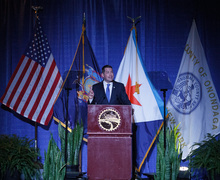Syracuse struggles to solve transition woes
Max Fruend | Contributing Photographer
Syracuse has posted a 30.2 field-goal percentage on an initial fast-break attempt (237th in the nation), according to Hoop-Math.com
Elijah Hughes leaned back in his seat and pursed his lips.
About an hour prior, during Syracuse’s 67-63 loss to Virginia Tech, SU’s defense trapped a Hokies player in front of the home bench. Four Orange jerseys swarmed, and the ball ricocheted toward mid-court. Buddy Boeheim got to it first, but the ball was smacked away and eventually trickled from Hughes and into a Tech guard’s possession. Head coach Jim Boeheim extended both hands toward Hughes during a media timeout. Syracuse transition woes once again ailed the offense, this time taking away a potential two-on-one break.
So, when Hughes was later asked in the locker room about a potential solution, Syracuse’s best player blew raspberries.
“That’s a good question,” Hughes, who finished with 18 points on six-for-16 shooting, said. “I don’t know. Get out and run more, I guess?”
The Orange scored just one transition point against the Hokies, their lowest output since totaling zero against Georgetown on Dec. 14. The last time they scored over 15 transition points was in late November. Syracuse’s (8-7, 1-3 Atlantic Coast) fast-break offense has produced diminishing returns, posting a 30.2 field-goal percentage on an initial fast-break attempt (237th in the nation), according to Hoop-Math.com. Bursts of individual skill haven’t masked overall issues. Before facing Virginia’s pack-line — a top-tier defense which limited SU to 34 points on Nov. 6 — solving the transition woes might offer a reprieve.
A young, sub-par Orange team has faced consistency issues all year. Its transition offense hasn’t been an outlier. After totaling 28 fastbreak points — a season-high — against Bucknell in a nonconference blowout, SU scored just 14 in a loss to Oklahoma State in the Barclays Center while allowing 35 against. Buddy Boeheim said after Syracuse’s early-season win over Colgate that transition offense will be key, and they needed to work on it.
“We’re not running,” freshman forward Quincy Guerrier said. “Taking the rebound, everyone is walking. I think we gotta run. We’re a pretty fast team but we’re not running enough.”
But to run more, which freshman Joe Girard III also offered as a fix, Syracuse would need a secondary ball-handler. Mainly, it’d need a guard to push up-court and feed its wing shooters. Girard has run SU’s offense for a majority of the season, and a lack of guard depth has left him as the lone operator on the break.
Sophomore Jalen Carey said in the preseason he was looking to run more this year. Instead he’s watched on the sidelines with a wrist injury. Brycen Goodine and Howard Washington are active, but Boeheim has kept the rotation limited. Twenty-six percent of SU’s total field goal attempts come on the break, but when Girard isn’t at the center, those shots have led to mixed results.
During a fast break against Notre Dame on Jan. 4, Girard deferred to Buddy in transition and filled the lane. Hughes rounded out the 3-on-1 fastbreak and found open space on the wing. Buddy instead looked toward the paint and tossed the ball out of bounds. The turnover came down the stretch in a close home loss, and Hughes walked across half-court with his hands atop his head.
Occasionally, Hughes will call for the ball after a rebound when he’s in an offensive groove. Junior Marek Dolezaj has also shown a penchant for going coast-to-coast. Dolezaj’s said repeatedly that he’s always looking to make plays, and, of late, he’s triggered offense in the half-court, too. Yet, his transition highlights are rare with the forward-handling-center duties as Bourama Sidibe’s up-and-down season continues.
“The problem is we’re not getting fast breaks because everyone is trying to help for rebounding,” Sidibe said. “We just gotta keep playing defense and that’s going to happen.”
Syracuse has averaged one fewer rebound per game than its opponents. Dolezaj and Hughes – two players who could pose transition threats – have committed themselves to the paint. The Orange roster itself is in a state of transition, hurtling towards a historic sub-.500 season. After the Barclays Center games, Boeheim said his team would take a while to be ready. But, as of Jan. 7 against Virginia Tech, some problems still don’t have answers.
“We’re not a running team,” Boeheim said post-Virginia Tech. “We’re not going to run the whole year. We don’t get rebounds or turnovers, we’re not gonna run.”
Published on January 9, 2020 at 5:48 pm
Contact Nick: nialvare@syr.edu | @nick_a_alvarez





